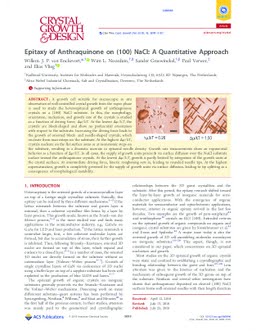2018-07-23
Epitaxy of Anthraquinone on (100) NaCl: A Quantitative Approach
Publication
Publication
Cryst. Growth Des. , Volume 18 p. 5099- 5107
A growth cell suitable for microscopic in situ observation of well-controlled crystal growth from the vapor phase is used to study the heteroepitaxial growth of anthraquinone crystals on a (100) NaCl substrate. In this, the morphology, orientation, nucleation, and growth rate of the crystals is studied as a function of driving force, Δμ/kT. At the lowest Δμ/kT, the crystals are block-shaped and show no preferential orientation with respect to the substrate. Increasing the driving force leads to the growth of oriented block- and needle-shaped crystals, which nucleate from macrosteps on the substrate. At the highest Δμ/kT, crystals nucleate on the flat surface areas or at monatomic steps on the substrate, resulting in a dramatic increase in epitaxial needle density. Growth rate measurements show an exponential behavior as a function of Δμ/kT. In all cases, the supply of growth units proceeds via surface diffusion over the NaCl substrate surface toward the anthraquinone crystals. At the lowest Δμ/kT, growth is partly limited by integration of the growth units at the crystal surfaces. At intermediate driving force, kinetic roughening sets in, leading to rounded needle tips. At the highest supersaturation, growth is completely governed by the supply of growth units via surface diffusion, leading to tip splitting as a consequence of morphological instability.
| Additional Metadata | |
|---|---|
| ACS | |
| doi.org/10.1021/acs.cgd.8b00546 | |
| Cryst. Growth Des. | |
| Organisation | Self-Organizing Matter |
|
van Enckevort, W., Noorduin, W., Graswinckel, S., Verwer, P., & Vlieg, E. (2018). Epitaxy of Anthraquinone on (100) NaCl: A Quantitative Approach. Cryst. Growth Des., 18, 5099–5107. doi:10.1021/acs.cgd.8b00546 |
|
